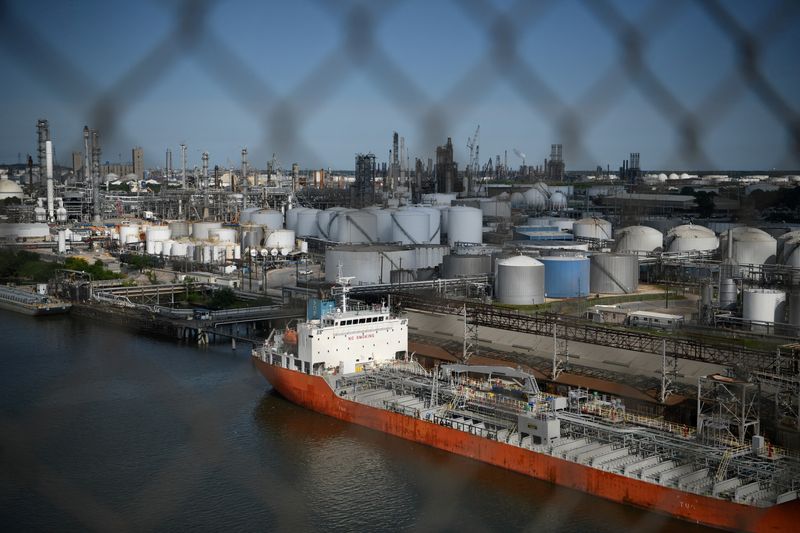Analysis-US Gulf Coast oil prices to take center stage as exports dominate
By Arathy Somasekhar
HOUSTON (Reuters) - Rising U.S. crude oil exports are boosting the prominence of Gulf Coast price benchmarks and buoying trading volumes on Houston contracts, eroding the significance of the Cushing, Oklahoma, storage hub.
Since U.S. WTI Midland crude oil transactions joined the dated Brent price assessment a year ago, U.S. oil exports have overshadowed the role of Cushing as a storage and pricing hub, traders and analysts said.
Cushing has been the delivery and pricing point for West Texas Intermediate crude futures (WTI) on the New York Mercantile Exchange (NYMEX) since 1983. The benchmark is currently used to price major U.S. crude grades for physical delivery, trading at a differential to WTI.
However, not long after the U.S. lifted its ban on crude exports in 2015 amid a shale boom that turned the country into the world's top producer, both the Intercontinental Exchange (NYSE:ICE ) and CME Group (NASDAQ:CME ), which owns NYMEX, launched contracts to trade and deliver crude from Midland, Texas, to terminals around Houston.
Average daily volumes on CME's WTI Houston contract more than doubled so far in September to a record high year on year, the exchange said.
An all-time high of over 18 million barrels were delivered against ICE's competing HOU contract, compared with less than 10 million barrels in August last year, ICE said.
Increasing liquidity in these contracts will create opportunities for hedging and arbitrage trades, leading to more deliveries in storage terminals in the region, and fewer into Cushing, oil market experts said.
"The physical market for U.S. production has already moved to the U.S. Gulf Coast, and now the futures market is following suit," said Jeff Barbuto, global head of oil markets at the Intercontinental Exchange (ICE).
While shale oil output from the Permian basin in Texas and New Mexico, the largest U.S. oilfield, has surged 3.6% to average 6.1 million barrels per day (bpd) so far this year, much of that oil is heading to storage closer to Gulf Coast export ports, or to refiners in the region.
"Where the big trade flow of crude oil is from the Permian and comes across to Houston, it kind of bypasses Cushing," said Colin Parfitt, a vice president at Chevron (NYSE:CVX ).
CME said that WTI continues to be the most liquid and significant benchmark and that Gulf Coast is an important and growing market.
Inventories at the Gulf Coast stood at about 235 million barrels last week, about 7% higher than levels at the start of 2016 after the export ban was lifted.
Cushing storage bounced off 11 month lows to 22.8 million barrels last week, near operational minimums, and was about 64% lower than the levels at the start of 2016.
"If someone were to say a year ago, that Cushing (stocks) would be at rock bottom, you would think oil would be at $100," said James Cordier, founder of think tank Cordier Commodity Report. The U.S. benchmark was trading below $70 a barrel on Thursday.
COASTAL PRICES DOMINATE
The flagship price benchmark along the Gulf Coast, particularly for exports, is WTI at East Houston, also known as MEH as it represents WTI arriving by pipeline and traded at the Magellan's East Houston (MEH) terminal.
"U.S. exports are around 4 million (barrels) a day and Midland priced at East Houston is really the barometer on how to price U.S. exports," said Jeremy Irwin, senior oil markets analyst at researcher Energy Aspects.
"I don't see any incentive to why you would want to necessarily store barrels at Cushing," said Irwin. "What Cushing becomes is more of a flow-through hub, rather than a storage pricing hub."
Oil basins feeding Cushing have also lost some of their sparkle. U.S. crude output growth from secondary shale oil basins in North Dakota, Pennsylvania, Ohio and West Virginia have slowed. They historically helped fill Cushing's hundreds of storage tanks.
Canada's Trans Mountain pipeline expansion also has siphoned some of the crude oil that would have flowed to Cushing.
Source: Investing.com
